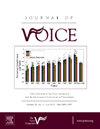Medications Adverse Effects on Voice: Comparison Between Different Sources of Information
IF 2.5
4区 医学
Q1 AUDIOLOGY & SPEECH-LANGUAGE PATHOLOGY
引用次数: 0
Abstract
Introduction
The analysis of drugs with adverse effects on voice provides relevant data for the vocal clinic. It is essential that professionals involved in voice care are aligned on the topic of voice pharmacovigilance in order to understand adverse effects from safe and reliable sources.
Objectives
To compare the voice adverse effects of self-reported medications by dysphonic individuals in different sources of information.
Methods
Descriptive and analytical study based on self-reported active ingredients by dysphonic individuals and their adverse effects on voice listed in Electronic Database of the National Health Surveillance Agency of Brazil (Anvisa). Adverse effects were comparatively analyzed between the Anvisa's Electronic Database and information from the Micromedex and UpToDate databases. Data were analyzed using descriptive and inferential statistics that compared the three sources researched in relation to the number of adverse effects and in relation to the occurrence of adverse effects to the voice.
Results
There was a statistically significant difference between the databases regarding the occurrence of adverse effects of cough, dyspnea, xerostomia, vomiting and hoarseness, with a higher occurrence in the UpToDate database. The UpToDate database showed a statistically significant difference in the amount of drug effects compared to the Anvisa database (P < 0.001, d = 0.744) and compared to the Micromedex database (P < 0.001, d = 0.598), and in the two cases the mean number of drug effects was higher for the UpToDate database.
Conclusions
UpToDate proved to be the most suitable source to complement the data from the medication package inserts at the time of the speech-language pathology assessment. It is recommended that professionals from all countries involved in voice care seek additional evidence-based sources of information to gain access to accurate and up-to-date data on adverse effects of drugs on voice.
药物对嗓音的不良影响:不同信息来源的比较。
简介分析对嗓音有不良影响的药物可为嗓音治疗提供相关数据。参与嗓音治疗的专业人员必须对嗓音药物警戒专题保持一致,以便从安全可靠的来源了解不良反应:比较不同信息来源中发音障碍患者自我报告的药物对嗓音的不良影响:描述性和分析性研究:根据发音障碍者自我报告的药物有效成分以及巴西国家卫生监督局(Anvisa)电子数据库中列出的药物对嗓音的不良影响。对 Anvisa 电子数据库与 Micromedex 和 UpToDate 数据库中的信息进行了不良反应比较分析。数据分析采用了描述性和推论性统计方法,比较了三种研究来源的不良反应数量和不良反应对嗓音的影响:结果:UpToDate 数据库中咳嗽、呼吸困难、口腔干燥症、呕吐和声音嘶哑等不良反应的发生率较高。UpToDate数据库与Anvisa数据库(P<0.001,d=0.744)和Micromedex数据库(P<0.001,d=0.598)相比,在药物效应数量上有显著的统计学差异,在这两种情况下,UpToDate数据库的药物效应平均数量更高:事实证明,UpToDate 是语言病理学评估时补充药物包装说明书数据的最合适来源。建议所有国家从事嗓音保健的专业人员寻求其他循证信息来源,以获得有关药物对嗓音不良影响的最新准确数据。
本文章由计算机程序翻译,如有差异,请以英文原文为准。
求助全文
约1分钟内获得全文
求助全文
来源期刊

Journal of Voice
医学-耳鼻喉科学
CiteScore
4.00
自引率
13.60%
发文量
395
审稿时长
59 days
期刊介绍:
The Journal of Voice is widely regarded as the world''s premiere journal for voice medicine and research. This peer-reviewed publication is listed in Index Medicus and is indexed by the Institute for Scientific Information. The journal contains articles written by experts throughout the world on all topics in voice sciences, voice medicine and surgery, and speech-language pathologists'' management of voice-related problems. The journal includes clinical articles, clinical research, and laboratory research. Members of the Foundation receive the journal as a benefit of membership.
 求助内容:
求助内容: 应助结果提醒方式:
应助结果提醒方式:


